Mongolia (![]() i /mɒŋˈɡoʊliə/; Mongolian:
i /mɒŋˈɡoʊliə/; Mongolian: ![]() Монгол улс (help·info), literally Mongol country/nation) is a landlocked country in East and Central Asia. It is bordered by Russia to the north and the People's Republic of China to the south, east and west. Although Mongolia does not share a border with Kazakhstan, its western-most point is only 38 kilometres (24 mi) from Kazakhstan's eastern tip. Ulaanbaatar, the capital and largest city, is home to about 38% of the population. Mongolia's political system is a parliamentary republic.
Монгол улс (help·info), literally Mongol country/nation) is a landlocked country in East and Central Asia. It is bordered by Russia to the north and the People's Republic of China to the south, east and west. Although Mongolia does not share a border with Kazakhstan, its western-most point is only 38 kilometres (24 mi) from Kazakhstan's eastern tip. Ulaanbaatar, the capital and largest city, is home to about 38% of the population. Mongolia's political system is a parliamentary republic.
The area of what is now Mongolia has been ruled by various nomadic empires, including the Xiongnu, the Xianbei, the Rouran, the Gökturks and others. The Mongol Empire was founded by Genghis Khan in 1206. After the collapse of the Yuan Dynasty, the Mongols returned to their earlier pattern of constant internal conflict and occasional raids on the Chinese borderlands. In the 16th and 17th centuries, Mongolia came under the influence of Tibetan Buddhism. At the end of the 17th century, most of Mongolia had been incorporated into the area ruled by the Qing Dynasty. During the collapse of the Qing Dynasty in 1911, Mongolia declared independence, but had to struggle until 1921 to firmly establish de facto independence from the Republic of China, and until 1945 to gain international recognition.
As a consequence, it came under strong Russian and Soviet influence; in 1924, the Mongolian People's Republic was declared, and Mongolian politics began to follow the same patterns as the Soviet politics of the time. After the breakdown of communist regimes in Eastern Europe in late 1989, Mongolia saw its own Democratic Revolution in early 1990, which led to a multi-party system, a new constitution in 1992, and transition to a market economy.
At 1,564,116 square kilometres (603,909 sq mi), Mongolia is the 19th largest and the most sparsely populated independent country in the world, with a population of around 2.9 million people. It is also the world's second-largest landlocked country after Kazakhstan. The country contains very little arable land, as much of its area is covered by steppes, with mountains to the north and west and the Gobi Desert to the south. Approximately 30% of the population are nomadic or semi-nomadic. The predominant religion in Mongolia is Tibetan Buddhism, and the majority of the state's citizens are of the Mongol ethnicity, though Kazakhs, Tuvans, and other minorities also live in the country, especially in the west. About 20% of the population live on less than US$1.25 per day.[9] Analysts have predicted that Mongolia can become one of fastest-growing economies of the 2010s, as well as a key investment target for global mining corporations.[10][11]
Contents[hide] |
History
Prehistory
Sites such as Tsagaan Agui (White Cave) in Bayankhongor Province show that Homo erectus inhabited Mongolia from 800,000 years ago.[12] Modern humans reached Mongolia approximately 40,000 years ago during the Upper Paleolithic. The Khoid Tsenkher Cave[13] in Khovd Province shows lively pink, brown and red ochre paintings (20,000 years ago) of mammoths, lynx, bactrian camels and ostriches, earning it the nickname "the Lascaux of Mongolia". The Mal'ta Venus (21,000 years ago) testifies to the level of Upper Paleolithic art in northern Mongolia, though Mal'ta is now part of Russia.
Neolithic agricultural settlements (c. 5500-3500 BC) such as those at Norovlin, Tamsagbulag, Bayanzag and Rashaan Khad predated the introduction of horse-riding nomadism, a pivotal event in the history of Mongolia as it became the dominant lifestyle. Horse-riding nomadism is first seen in Mongolia during the Copper and Bronze Age Afanasevo culture (3500-2500 BC) which stretched to the Khangai Mountains in Central Mongolia. The wheeled vehicles found in the burials of the Afanasevans have been dated to before 2200 BC.[14] Pastoral nomadism and metalworking became more and more developed with the later Okunev Culture (2nd millennium BC), Andronovo culture (2300-1000 BC) and Karasuk culture (1500-300 BC), culminating with the Iron Age Xiongnu Empire in 209 BC. Monuments of the pre-Xiongnu Bronze Age include deer stones, keregsur kurgans, square slab tombs and rock paintings.
Although cultivation of crops continued since the Neolithic it always remained small-scale compared to pastoral nomadism, which was first introduced from the west. The population during the Copper Age has been described as paleomongoloid in the east of what is now Mongolia, and as europoid in the west.[13] Tocharians (Yuezhi) and Scythians inhabited western Mongolia during the Bronze Age. The mummy of a Scythian warrior, which is believed to be about 2,500 years old was a 30-to-40 year-old man with blond hair, and was found in the Altai, Mongolia.[15] As horse nomadism was introduced into Mongolia the political center of the Eurasian Steppe also shifted to Mongolia, where it remained until the 18th century CE. The intrusions of northern pastoralists (e.g. Guifang, Shanrong, Donghu) into China during the Shang dynasty (1600-1046 BC) and Zhou dynasty (1046-256 BC) presaged the age of nomadic empires.
Early history

Mongolia, since prehistoric times, has been inhabited by nomads who, from time to time, formed great confederations that rose to prominence. The first of these, the Xiongnu of undetermined ethnicity, were brought together to form a confederation by Modu Shanyu in 209 BC. Soon they emerged as the greatest threat to the Qin Dynasty, forcing the latter to construct the Great Wall of China, itself being guarded by up to almost 300,000 soldiers during marshal Meng Tian's tenure, as a means of defense against the destructive Xiongnu raids.
The vast Xiongnu empire (209 BC-93 AD) was followed by the Mongolic Xianbei empire (93-234) which also ruled more than the entirety of present-day Mongolia. The Mongolic Rouran Khaganate (330-555), of Xianbei provenance, ruled a massive empire before being defeated by the Göktürks (555-745) whose empire was even bigger (laid siege to Panticapaeum, present-day Kerch, in 576). They were succeeded by the Uyghur Khaganate (745-840) who were defeated by the Kyrgyz. The Mongolic Khitans ruled Mongolia during the Liao Dynasty (907-1125) after which the Khamag Mongol (1125–1206) rose to prominence.
Mongol Empire
In the chaos of the late 12th century, a chieftain named Temüjin finally succeeded in uniting the Mongol tribes between Manchuria and the Altai Mountains. In 1206, he took the title Genghis Khan, and waged a series of military campaigns - renowned for their brutality and ferocity - sweeping through much of Asia, and forming the Mongol Empire, the largest contiguous land empire in world history. Under his successors it stretched from present-day Poland in the west to Korea in the east, and from Siberia in the north to the Gulf of Oman and Vietnam in the south, covering some 33,000,000 square kilometres (13,000,000 sq mi),[16] (22% of Earth's total land area) and having a population of over 100 million people.
After Genghis Khan's death, the empire was subdivided into four kingdoms or Khanates which eventually became quasi-independent after Möngke's death in 1259. One of the khanates, the "Great Khaanate", consisting of the Mongol homeland and China, became the Yuan Dynasty under Kublai Khan, the grandson of Genghis Khan. He set up his capital in present day Beijing but after more than a century of power, the Yuan was replaced by the Ming Dynasty in 1368, with the Mongol court fleeing to the north. As the Ming armies pursued the Mongols into their homeland, they successfully sacked and destroyed the Mongol capital Karakorum among other cities, wiping out the cultural progress that was achieved during the imperial period and thus throwing Mongolia back to anarchy.
The Mongol Empire had significantly eased trade and commerce across Asia during its height. The communications between Yuan Dynasty and the Ilkhanate in Persia encouraged this development.[17][18]
Post-imperial period
After the expulsion of the Yuan Dynasty from China, the Mongols continued to rule Mongolia, also referred to as the Northern Yuan. The next centuries were marked by violent power struggles between various factions, notably the Genghisids and the non-Genghisid Oirads and numerous Chinese invasions (like the five expeditions led by the Yongle Emperor). In the early 15th century, the Oirads under Esen Tayisi gained the upper hand, and even raided China in 1449 in a conflict over Esen's right to pay tribute, capturing the Chinese emperor in the process. However, Esen was murdered in 1454, and the Borjigids recovered.
Batumöngke Dayan Khan and his khatun Mandukhai reunited the entire Mongols under the Genghisids in the early 16th century. In the mid-16th century, Altan Khan of the Tümed, a grandson of Batumöngke - but no legitimate Khan himself - became powerful. He founded Hohhot in 1557 and his meeting with the Dalai Lama in 1578 sparked the second introduction of Tibetan Buddhism to Mongolia. Abtai Khan of the Khalkha converted to buddhism and founded the Erdene Zuu monastery in 1585. His grandson Zanabazar became the first Jebtsundamba Khutughtu in 1640.
Under the Qing Dynasty
The last Mongol Khan was Ligden Khan in the early 17th century. He got into conflicts with the Manchus over the looting of Chinese cities, and managed to alienate most Mongol tribes. He died in 1634 on his way to Tibet, in an attempt to evade the Manchus and destroy the Yellow Hat sect of Buddhism. By 1636, most Inner Mongolian tribes had submitted to the Manchus, who founded the Qing Dynasty. The Khalkha eventually submitted to Qing rule in 1691, thus bringing all but the west of today's Mongolia under Beijing's rule. After several wars, the Dzungars (the western Mongols or Oirads) were virtually annihilated in 1757–58.[19] Outer Mongolia was given relative autonomy, being administered by the hereditary Genghisid khanates of Tusheet Khan, Setsen Khan, Zasagt Khan and Sain Noyon Khan. The Jebtsundamba Khutuktu of Mongolia had immense de-facto authority. The Manchus also forbade mass Chinese immigration, allowing the Mongols to keep their culture.
Until 1911, Qing Dynasty maintained control of Mongolia with a series of alliances and intermarriages, as well as military and economic measures. Ambans, Manchu "high officials", were installed in Khüree, Uliastai, and Khovd, and the country was subdivided into ever more feudal and ecclesiastical fiefdoms. Over the course of the 19th century, the feudal lords attached more importance to representation and less importance to the responsibilities towards their subjects. The behaviour of Mongolia's nobility, together with the usurious practices of the Chinese traders and the collection of imperial taxes in silver instead of animals, resulted in poverty becoming ever more rampant.
Independence
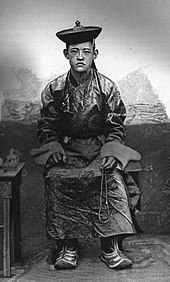
With the fall of the Qing Dynasty, Mongolia under the Bogd Khaan declared independence in 1911. However, the newly established Republic of China considered Mongolia as part of its own territory. The area controlled by the Bogd Khaan was approximately that of the former Outer Mongolia during Qing period. In 1919, after the October Revolution in Russia, Chinese troops led by Xu Shuzheng occupied Mongolia.
However, as a result of the Russian Civil War, the White Russian adventurer Baron Ungern led his troops into Mongolia in October 1920, defeating the Chinese forces in Niislel Khüree (Ulaanbaatar) in early February 1921. In order to eliminate the threat posed by Ungern, Bolshevik Russia decided to support the establishment of a communist Mongolian government and army. This Mongolian army took the Mongolian part of Kyakhta from Chinese forces on March 18, 1921, and on July 6 Russian and Mongolian troops arrived in Khüree. Mongolia's independence was declared once again on July 11, 1921.[20] These events led to Mongolia's close alignment with the Soviet Union over the next seven decades.
Mongolian People's Republic
In 1924, after the death of the religious leader and king Bogd Khan, a Mongolian People's Republic was proclaimed with support from the Soviet Union.

In 1928, Khorloogiin Choibalsan rose to power. He instituted collectivisation of livestock, the destruction of Buddhist monasteries and the Mongolia's enemies of the people persecution resulting in the murder of monks and other people. In Mongolia during the 1920s, approximately one third of the male population were monks. By the beginning of the 20th century about 750 monasteries were functioning in Mongolia.[21] The Stalinist purges in Mongolia beginning in 1937, affected the Republic as it left more than 30,000 people dead. Japanese imperialism became even more alarming after the invasion of neighboring Manchuria in 1931. During the Soviet-Japanese Border War of 1939, the Soviet Union successfully defended Mongolia against Japanese expansionism.
In August 1945 Mongolian forces also took part in the Soviet Manchurian Strategic Offensive Operation in Inner Mongolia. The Soviet threat of seizing parts of Inner Mongolia[citation needed] induced China to recognize Outer Mongolia's independence, provided that a referendum was held. The referendum took place on October 20, 1945, with (according to official numbers) 100% of the electorate voting for independence. After the establishment of the People's Republic of China, both countries confirmed their mutual recognition on October 6, 1949.
On January 26, 1952, Yumjaagiin Tsedenbal took power. In 1956 and again in 1962, Choibalsan's personality cult was condemned at the ruling Mongolian People's Revolutionary Party Central Committee plenums. Mongolia continued to align itself closely with the Soviet Union, especially after the Sino-Soviet split of the late 1950s. In the 1980s, an estimated 55,000 Soviet troops were based in Mongolia. While Tsedenbal was visiting Moscow in August 1984, his severe illness prompted the parliament to announce his retirement and replace him with Jambyn Batmönkh.
Democratic revolution
The introduction of perestroika and glasnost in the USSR by Mikhail Gorbachev strongly influenced Mongolian politics leading to the peaceful Democratic Revolution and the introduction of a multi-party system and market economy. A new constitution was introduced in 1992, and the "People's Republic" was dropped from the country's name. The transition to market economy was often rocky, the early 1990s saw high inflation and food shortages. The first election wins for non-communist parties came in 1993 (presidential elections) and 1996 (parliamentary elections). The signing of the Oyu Tolgoi mine contract is considered a major milestone in modern Mongolian history. The Mongolian People's Revolutionary Party renamed itself the Mongolian People's Party in 2010.
Government and politics
Mongolia is a parliamentary republic. The parliament is elected by the people and in turn elects the government. The president is elected directly. Mongolia's constitution guarantees full freedom of expression, religion, and others. Mongolia has a number of political parties, the biggest ones being the Mongolian People's Party (MPP or MPRP) and the Democratic Party (DP).
The MPRP formed the government of the country from 1921 to 1996 (until 1990 in a one-party system) and from 2000 to 2004. From 2004 to 2006, it was part of a coalition with the DP and two other parties, and since 2006 it has been the dominant party in two other coalitions. Both changes of government after 2004 were initiated by the MPRP. The DP was the dominant force in the ruling coalition between 1996 and 2000, and also an approximately equal partner with the MPRP in the 2004-2006 coalition. The MPRP won the last round of parliamentary elections, held in June 2008.
President
Mongolia's president has a largely symbolic role, but can block the Parliament's decisions, who can then overrule the veto by a two-thirds majority. Mongolia's constitution provides three requirements for taking office as president; the candidate must be a native-born Mongolian, be at least 45 years of age, and have resided in Mongolia for five years prior to taking office. The president is also required to formally resign his or her party membership. The current president is Tsakhiagiin Elbegdorj, a former two-time prime minister and member of the Democratic Party. He was elected as president on May 24, 2009 and inaugurated on June 18.
The State Great Khural
Mongolia uses a unicameral parliamentary system in which the president has a symbolic role and the government chosen by the legislature exercises executive power. The legislative arm, the State Great Khural, has one chamber with 76 seats and is chaired by the speaker of the house. It elects its members every four years by general elections. The State Great Khural is powerful in the Mongolian government with the president being largely symbolic and the prime minister being confirmed from the parliament.
Prime Minister and the cabinet
The Prime Minister of Mongolia is elected by the State Great Khural. The current prime minister is Sükhbaataryn Batbold who assumed the office on 29 October 2009. The deputy prime minister is Norovyn Altankhuyag. There are ministers of each department (finance, defense, labor, agriculture, etc.) and those offices constitute the prime minister's cabinet.
The cabinet is nominated by the prime minister in consultation with the president and confirmed by the State Great Khural.
Foreign relations and military

Mongolia maintains positive relations and has diplomatic missions with many countries such as Russia, the People's Republic of China, India, North and South Korea, Japan, and the United States. The government has focused a great deal on encouraging foreign investments and trade. Mongolia supported the 2003 invasion of Iraq, and has sent several successive contingents of 103 to 180 troops each to Iraq. About 130 troops are currently deployed in Afghanistan. 200 Mongolian troops are serving in Sierra Leone on a UN mandate to protect the UN's special court set up there, and in July 2009, Mongolia decided to send a battalion to Chad in support of MINURCAT.[22]
From 2005 to 2006, about 40 troops were deployed with the Belgian and Luxembourgish contingent in Kosovo. On November 21, 2005, George W. Bush became the first-ever sitting U.S. President to visit Mongolia.[23] In 2004, under the Bulgarian chairmanship, The Organisation for Security and Cooperation in Europe (OSCE), invited Mongolia as its newest Asian Partner.
Mongolia has embassies in Almaty, Ankara, Bangkok, Berlin, Beijing, Brussels, Budapest, Cairo, Canberra, Warsaw, Washington, D.C., Vienna, Vientiane, Havana, Delhi, Kuwait City, London, Moscow, Ottawa, Paris, Prague, Pyongyang, Seoul, Sofia, Stockholm, Tokyo, Hanoi, and Singapore, a consulate in Irkutsk and Ulan-Ude, and diplomatic missions to the United Nations in New York City and in Geneva.[24]
Geography and climate
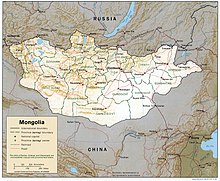
At 1,564,116 km2 (603,909 sq mi),[25] Mongolia is the world's 19th-largest country (after Iran). It is significantly larger than the next-largest country, Peru. It mostly lies between latitudes 41° and 52°N (a small area is north of 52°), and longitudes 87° and 120°E.
The geography of Mongolia is varied with the Gobi Desert to the south and with cold and mountainous regions to the north and west. Much of Mongolia consists of steppes. The highest point in Mongolia is the Khüiten Peak in the Tavan bogd massif in the far west at 4,374 m (14,350 ft). The basin of the lake Uvs Nuur, shared with Tuva Republic in Russia, is a natural World Heritage Site. Most of the country is hot in the summer and extremely cold in the winter, with January averages dropping as low as −30 °C (−22 °F).[26]
The country is also subject to occasional harsh climatic conditions known as zud. Ulan Bator has the lowest average temperature of any national capital in the world. Mongolia is high, cold, and windy. It has an extreme continental climate with long, cold winters and short summers, during which most of its annual precipitation falls. The country averages 257 cloudless days a year, and it is usually at the center of a region of high atmospheric pressure. Precipitation is highest in the north (average of 200 to 350 millimeters (7.9 to 13.8 in) per year) and lowest in the south, which receives 100 to 200 millimeters (3.9 to 7.9 in) annually. The extreme south is the Gobi, some regions of which receive no precipitation at all in most years.
The name "Gobi" is a Mongol term for a desert steppe, which usually refers to a category of arid rangeland with insufficient vegetation to support marmots but with enough to support camels. Mongols distinguish Gobi from desert proper, although the distinction is not always apparent to outsiders unfamiliar with the Mongolian landscape. Gobi rangelands are fragile and are easily destroyed by overgrazing, which results in expansion of the true desert, a stony waste where not even Bactrian camels can survive.
Administrative divisions
Mongolia is divided into 21 aimags (provinces), which are in turn divided into 329 sums (districts).[27] The capital Ulaanbaatar is administrated separately as a khot (municipality) with provincial status. The aimags are:
| |
Major cities
The largest city in Mongolia is Ulan Bator, with a population of just over 1 million, followed by Erdenet, Darkhan, Choibalsan, and Mörön.
Economy

Mongolia's economy is centered on agriculture and mining. Mongolia has rich mineral resources, and copper, coal, molybdenum, tin, tungsten, and gold account for a large part of industrial production. In March 2011, six big mining companies prepared to bid for the Tavan Tolgoi area, which is the world's largest untapped coking coal deposit.[28]
There are currently over 30,000 independent businesses in Mongolia, chiefly centered around the capital city.[citation needed] The majority of the population outside urban areas participates in subsistence herding; livestock typically consists of sheep, goats, cattle, horses, and Bactrian camels. Agricultural crops include wheat, barley, potato, vegetables, tomato, watermelon, sea-buckthorn and fodder crops. GDP per capita in 2006 was $2,100.[29]
Although GDP has risen steadily since 2002 at the rate of 7.5% in an official 2006 estimate, the state is still working to overcome a sizable trade deficit. A massive ($11 billion) foreign debt to Russia was settled by the Mongolian government in 2004 with a $250 million payment.[citation needed] Despite growth, the proportion of the population below the poverty line is estimated to be 35.6% in 1998, 36.1% in 2002–2003, 32.2% in 2006,[30] and both the unemployment rate and inflation rate are relatively high[citation needed] at 3.2% and 6.0%, respectively (in 2006). Mongolia's largest trading partner is China. As of 2006, 68.4% of Mongolia's exports went to China, and China supplied 29.8% of Mongolia's imports.[31]
Mongolia previously never listed as Emerging markets countries until February 2011 when Citigroup analysts determined Mongolia as one of Global Growth Generators countries which being countries with the most promising growth prospects for 2010-2050.[32]
The Mongolian Stock Exchange, established in 1991 in Ulan Bator, is the world's smallest stock exchange by market capitalisation.[33][34] In 2010, the Mongolian Stock Exchange had 336 companies listed with a total market capitalization of US$1 billion after doubling from US$406 million in 2008[35].
Industrial sector
Industry currently accounts for 21.4% of GDP, approximately equal to the weight of the agriculture sector (20.4%). These industries include construction materials, mining (coal, copper, molybdenum, fluorspar, tin, tungsten, and gold), oil, food and beverages, processing of animal products, and cashmere and natural fiber manufacturing. The industrial production growth rate is estimated to be 4.1% in 2002. Mining is continuing to rise as a major industry of Mongolia as evidenced by number of Chinese, Russian and Canadian firms opening and starting mining business in Mongolia.[29] Domestic food production, especially packaged food production has been increasingly coming up with speed with investments from foreign companies.
Science and technology
Some technology companies from nearby countries, such as South Korea and the People's Republic of China, have started to open offices in Mongolia. Those companies have tended to focus on software development rather than hardware production[citation needed]. A number of telecommunications companies and Internet service providers have been established resulting in greater competition in the Internet and phone market, especially in cell phones like Mobicom Corporation and Magicnet, that are the largest cellphone and ISP operators in Mongolia respectively.
Service sector

After the transition shocks of the early 1990s, Mongolian domestic production has picked up again. According to the CIA World Factbook, in 2008, the service sector accounted for 49% of the GDP, with 61% of the labor force of 1.06 million involved.
Foreign investment from other countries (including China, Japan, South Korea, Germany[citation needed] and Russia) has helped to add more paved roads. The most important is a 1000 km north-south road leading from the Russian border at Sükhbaatar to the Chinese border at Zamyn-Üüd. There are several air transport companies in Mongolia, including MIAT, Aero Mongolia, and Eznis Airways.
Petroleum products are mainly (80%) imported from Russia, which makes Mongolia vulnerable to supply side shocks. This is one strong example of the influence of Mongolia's neighbors on its economy.
Transportation
The Trans-Mongolian Railway is the main rail link between Mongolia and its neighbors. It begins at the Trans-Siberian Railway in Russia at the town of Ulan-Ude, crosses into Mongolia, runs through Ulaanbaatar, then passes into China at Erenhot where it joins the Chinese railway system. A separate railroad link connects the eastern city of Choibalsan with the Trans-Siberian Railway. However, that link is closed to passengers after the Mongolian town of Chuluunkhoroot.[36]
Mongolia has a number of domestic airports. The only international airport is the Chinggis Khaan International Airport near Ulaanbaatar. Direct flight connections exist between Mongolia and South Korea, China, Japan, Russia and Germany. MIAT is Mongolia's largest carrier in Mongolia and provides both domestic[citation needed] and international flights.
Most overland roads in Mongolia are only gravel roads or simple cross-country tracks. There are paved roads from Ulaanbaatar to the Russian and Chinese border, and from Darkhan to Bulgan. Some road construction projects are currently underway — for example, construction of the east–west so-called Millennium Road.
Demographics

Mongolia's total population as of July 2007 is estimated by U.S. Census Bureau[37] at 2,951,786 people, ranking at around 138th in the world in terms of population. But the U.S. Department of State Bureau of East Asian and Pacific Affairs uses the U.N. estimations[38] instead of the U.S. Census Bureau estimations. United Nations Department of Economic and Social Affairs Population Division[39] estimates Mongolia's total population (mid 2007) as 2,629,000 (11% less than the U.S. Census Bureau figure). UN estimates resemble those made by the Mongolian National Statistical Office (2,612,900, end of June 2007). Mongolia's population growth rate is estimated at 1.2% (2007 est.).[39] About 59% of the total population is under age 30, 27% of whom are under 14. This relatively young and growing population has placed strains on Mongolia's economy.
Since the end of socialism, Mongolia has experienced a decline of total fertility rate (children per woman) that is steeper than in any other country in the world, according to recent UN estimations:[39] in 1970-1975, fertility was estimated to be 7.33 children per woman, but 2005-2010 prospects are 1.87 (4 times less).
Mongolia has become more urbanized. About 40% of the population lives in Ulaanbaatar, and in 2002 a further 23% lived in Darkhan, Erdenet, the aimag centers and sum-level permanent settlements.[40] Another share of the population lives in the sum centers. In 2002, about 30% of all households in Mongolia lived from breeding lifestock.[41] Most herders in Mongolia follow a pattern of nomadic or semi-nomadic pastoralism.
Ethnic Mongols account for about 85% of the population and consist of Khalkha and other groups, all distinguished primarily by dialects of the Mongol language. The Khalkha make up 90% of the ethnic Mongol population. The remaining 10% include Buryats, Durbet Mongols and others in the north and Dariganga Mongols in the east. Turkic peoples (Kazakhs, Tuvans, and Chantuu (Uzbek) constitute 7% of Mongolia's population, and the rest are Tungusic peoples, Chinese,[42] and Russians.[43] Most but not all Russians left the country following the withdrawal of economic aid and dissolution of the Soviet Union in 1991.
Languages
The official language of Mongolia is Khalkha Mongolian, and is spoken by 90% of the population. A variety of dialects of Oirat and Buryat are spoken across the country, and there are also some speakers of Mongolic Khamnigan. In the west of the country, Kazakh and Tuvan, both Turkic languages, are also spoken.
Today, Mongolian is written using the Cyrillic alphabet, although in the past it was written using the Mongolian script. An official reintroduction of the old script was planned for 1994, but has not yet taken place as older generations encountered practical difficulties. [44] The traditional alphabet is being slowly reintroduced through schools. [45]
The Russian language is the most frequently spoken foreign language in Mongolia, followed by English, though English has been gradually replacing Russian as the second language.[citation needed] Korean has gained popularity as tens of thousands of Mongolians work in South Korea.[46] Interest in Chinese, as the language of the other neighbouring power, has been growing. Japanese is also popular among the younger people. A number of older educated Mongolians speak some German, as they studied in the former East Germany, while a few speak other languages from the former Eastern Bloc. Besides that, many younger Mongolians are fluent in the Western European languages as they study or work in foreign countries including Germany, France and Italy.
Deaf people in Mongolia use Mongolian Sign Language.
Religion

More than 90% of Mongolian citizens subscribed to some form of Buddhism, mostly Tibetan Buddhism with traditional Shamanism. 5% of Mongolia are Muslim, of which 120,000 are Kazakh Muslims, and 30,000 are Khoton Muslims. More than 4% of the population practices Christianity, of which an estimated 90% are Protestant and 9% are members of The Church of Jesus Christ of Latter-day Saints (Mormons). Roman Catholics and members of the Russian Orthodox Church together account for the remaining 1%.[47]
Various forms of Tengriism and Shamanism have been widely practiced throughout the history of what is now modern day Mongolia, as such beliefs were common among nomadic people in Asian history. Such beliefs gradually gave way to Tibetan Buddhism, but Shamanism has left a mark on Mongolian religious culture, and continues to be practiced. In the three Western khanates of the Mongol Empire, which were established on Muslim territories, the Mongol conqueror elites eventually adopted Islam (along with other aspects of the local cultures, including the indigenous languages).[48]
Throughout much of the 20th century, the communist government ensured that the religious practices of the Mongolian people were largely repressed.[citation needed] It targeted the clergy of the Mongolian Tibetan Buddhist Church, which had been tightly intertwined with the previous feudal government structures (e.g. from 1911 on, the head of the Church had also been the khan of the country).[49] In the late 1930s, the regime, then led by Khorloogiin Choibalsan, closed almost all of Mongolia's over 700 Buddhist monasteries and killed at least 18.000 lamas.[50] The number of Buddhist monks dropped from 100,000 in 1924 to 110 in 1990.[49]
The fall of communism in 1991 restored the legality of public religious practice, and Tibetan Buddhism, which had been the predominant religion in the region before the rise of communism, again rose to become the most widely practiced religion in Mongolia. The end of religious repression in the 1990s also allowed for other religions, such as Islam, Baha'i Faith and Christianity, to spread in the country. According to the Christian missionary group Barnabas Fund, the number of Christians grew from just four in 1989 to around 40,000 as of 2008.[51]
Education
During the state socialist period, education was one of the areas of significant achievement in Mongolia. Illiteracy was virtually eliminated, in part through the use of seasonal boarding schools for children of nomadic families. Funding to these boarding schools was cut in the 1990s, contributing to slightly increased illiteracy.
Primary and secondary education formerly lasted 10 years, but was expanded to 11 years. Since the 2008-2009 school year, new first graders are using the 12 year system. As such, full transition to the 12-year system will not happen until the 2019-2020 school year, when the current third graders graduate.[52]
Mongolian national universities are all spin-offs from the National University of Mongolia and the Mongolian University of Science and Technology.
The broad liberalization of the 1990s led to a boom in private institutions of higher education, although many of these establishments have difficulty living up to their name of "college" or "university".[citation needed]
Health
Since 1990, key health indicators like life expectancy and infant and child mortality have steadily improved, both due to social changes and to improvement in the health sector. However, serious problems remain, especially in the countryside.[53]
Average childbirth (fertility rate) is around 2.25[37] - 1.87[39] per woman (2007) and average life expectancy is 67[37]-68[39] years. Infant mortality is at 1.9%[54]-4%[55] and child mortality is at 4.3%.[56]
The health sector comprises 17 specialized hospitals and centers, 4 regional diagnostic and treatment centers, 9 district and 21 aimag general hospitals, 323 soum hospitals, 18 feldsher posts, 233 family group practices, and 536 private hospitals and 57 drug supply companies/pharmacies. In 2002 the total number of health workers was 33,273, of which 6823 were doctors, 788 pharmacists, 7802 nurses, and 14,091 mid-level personnel. At present, there are 27.7 physicians and 75.7 hospital beds per 10,000 inhabitants.
Culture
The main festival is Naadam, which has been organised for centuries, consists of three Mongolian traditional sports, archery, horse-racing (over long stretches of open country, not the short racing around a track practiced in the West), and wrestling. Nowadays it is held on July 11 to July 13 in the honour of the anniversaries of the National Democratic Revolution and foundation of the Great Mongol State. Another very popular activity called Shagaa is the "flicking" of sheep ankle bones at a target several feet away, using a flicking motion of the finger to send the small bone flying at targets and trying to knock the target bones off the platform. This contest at Naadam is very popular and develops a serious audience among older Mongolians. In Mongolia, the khoomei (or throat singing), style of music is popular, particularly in parts of Western Mongolia.
The ornate symbol in the leftmost bar of the national flag is a Buddhist icon called Soyombo. It represents the sun, moon, stars, and heavens per standard cosmological symbology abstracted from that seen in traditional thangka paintings.
Sports and recreation

Mongolia's Naadam festival takes place over three days in the summer and includes horse racing, archery, and Mongolian wrestling. These three sports, traditionally recognized as the three primary masculine activities, are the most widely watched and practiced sports throughout the country.
Horse riding is especially central to Mongolian culture. The long-distance races that are showcased during Naadam festivals are one aspect of this, as is the popularity of trick riding. One example of trick riding is the legend that the Mongolian military hero Damdin Sükhbaatar scattered coins on the ground and then picked them up while riding a horse at full gallop.
Other sports such as table tennis, basketball, and soccer are increasingly getting popular. More Mongolian table tennis players are competing internationally.
Wrestling is the most popular of all Mongol sports. It is the highlight of the Three Manly Games of Naadam. Historians claim that Mongol-style wrestling originated some seven thousand years ago. Hundreds of wrestlers from different cities and aimags around the country take part in the national wrestling competition.
There are no weight categories or age limits. Each wrestler has his own attendant herald. The aim of the sport is to knock one's opponent off balance and throw him down, making him touch the ground with his elbow and knee.
The winners are honored with ancient titles: the winner of the fifth round gets the honorary title of nachin (falcon), of the seventh and eighth rounds zaan (elephant), and of the tenth and eleventh rounds arslan (lion). The wrestler who becomes the absolute champion is awarded the title of avarga (Titan). Every subsequent victory at the national Naadam-festival will add an epithet to the avarga title, like "Invincible Titan to be remembered by all". Beginning in 2003, the Mongolian parliament adopted a new law on Naadam, making amendments to some of the wrestling titles. The titles of iarudi and Khartsaga (Hawk) were added to the existing above-mentioned rules.
The traditional wrestling costume includes an open-fronted jacket, tied around the waist with a string. This is said to have come into use after the champion of a wrestling competition many years ago was discovered to be a woman. The jacket was introduced to ensure that only men could compete.
International sports
Mongolia's traditional wrestlers have made the transition to Japanese sumo wrestling with great success. Asashōryū Akinori was the first Mongolian to be promoted to the top sumo rank of yokozuna in 2003 and was followed by his countryman Hakuhō Shō in 2007.
Naidangiin Tüvshinbayar won Mongolia's first ever Olympic gold medal in the men's 100-kilogram class of judo.[57]
Football is also played in Mongolia. The Mongolia national football team began playing again in the 1990s; it has yet to qualify for a major tournament. The Mongolia Premier League is the top domestic competition.
Several Mongolian women have excelled in pistol shooting: Otryadyn Gündegmaa is a silver medalist of the 2008 Olympic Games, Munkhbayar Dorjsuren is a double world champion and Olympic bronze medal winner (now representing Germany), while Tsogbadrakhyn Mönkhzul is, as of May 2007, ranked third in the world in the 25 m Pistol event.[58]
Architecture
The traditional Mongolian dwelling is known as a ger. In the past it was known by the Russian term yurt, but this is changing as the Mongolian term becomes better known among English-speaking countries. According to Mongolian artist and art critic N. Chultem, the ger was the basis for development of traditional Mongolian architecture. In the 16th and 17th centuries, lamaseries were built throughout the country. Many of them started as ger-temples. When they needed to be enlarged to accommodate the growing number of worshippers, the Mongolian architects used structures with 6 and 12 angles[clarification needed] with pyramidal roofs to approximate to the round shape of a ger. Further enlargement led to a quadratic shape of the temples. The roofs were made in the shape of marquees.[59] The trellis walls, roof poles and layers of felt were replaced by stone, brick, beams and planks, and became permanent.[60]
Chultem distinguished three styles in traditional Mongolian architecture: Mongolian, Tibetan and Chinese as well as combinations of the three. Among the first quadratic temples was Batu-Tsagaan (1654) designed by Zanabazar. An example of the ger-style architecture is the lamasery Dashi-Choiling in Ulaanbaatar. The temple Lavrin (18th century) in the Erdene Zuu lamasery was built in the Tibetan tradition. An example of a temple built in the Chinese tradition is the lamasery Choijing Lamiin Sume (1904), which is a museum today. The quadratic temple Tsogchin in lamasery Gandan in Ulan Bator is a combination of the Mongolian and Chinese tradition. The temple of Maitreya (disassembled in 1938) is an example of the Tibeto-Mongolian architecture.[59] Dashi-Choiling monastery has commenced a project to restore the temple and the 80 feet (24 m) sculpture of Maitreya.
Music

The music of Mongolia is strongly influenced by nature, nomadism, shamanism, and also Tibetan Buddhism. The traditional music includes a variety of instruments, famously the morin khuur, and also the singing styles like the urtyn duu ("long song"), and throat-singing (khoomei). The "tsam" is danced to keep away evil spirits and it was seen the reminiscences of shamaning.
Popular music
The first rock band of Mongolia was Soyol Erdene, founded in the 1960s. Their Beatles-like manner was severely criticised by the Communist censorship. It was followed by Mungunhurhree, Ineemseglel, Urgoo, etc., carving out the path for the genre in the harsh environment of Communist ideology. Mungunhurhree and Haranga were to become the pioneers in the Mongolia's heavy rock music. Haranga approached its zenith in the late 1980s and 1990s.
The leader of Haranga, famous guitarist Enh-Manlai, generously helped the growth of the following generations of rockers. Among the followers of Haranga was the band Hurd. In the early 1990s, group Har-Chono put the beginning for Mongolia's folk-rock, merging elements of the Mongolian traditional "long song" into the genre.
By that time, the environment for development of artistic thought had become largely liberal thanks to the new democratic society in the country. The 1990s saw development of rap, techno, hip-hop and also boy bands and girl bands flourish at the turn of the millennium.
Media

Mongolian press began in 1920 with close ties to the Soviet Union under the Mongolian Communist Party, with the establishment of the Unen ("Truth") newspaper similar to the Soviet Pravda.[61] Until reforms in the 1990s, the government had strict control of the media and oversaw all publishing, in which no independent media was allowed.[61] The dissolution of the Soviet Union had a significant impact on Mongolia, where the one-party state grew into a multi-party democracy, and with that, media freedoms came to the forefront.
A new law on press freedom, drafted with help from international NGOs on August 28, 1998 and enacted on January 1, 1999, paved the way for media reforms.[62] The Mongolian media currently consists of around 300 print and broadcasting outlets.[63]
Since 2006, the media environment has been improving with the government debating a new Freedom of Information Act, and the removal of any affiliation of media outlets with the government.[64][65] Market reforms have led to an increasing number of people working in the media year on year, along with students at journalism schools.[64] In its 2008 report, Reporters Without Borders classified the media environment as 93rd out of 173, with 1st being most free.[66]
Gallery
-
A Khulan (Mongolian Wild Ass) on a hill in the Gobi of Mongolia at sunset.


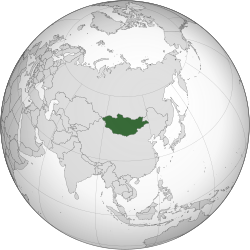


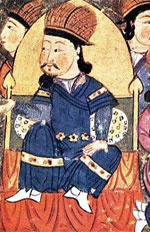

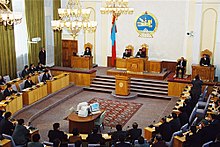




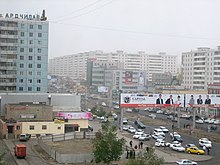
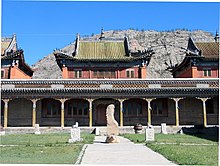





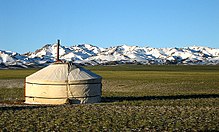






No comments:
Post a Comment